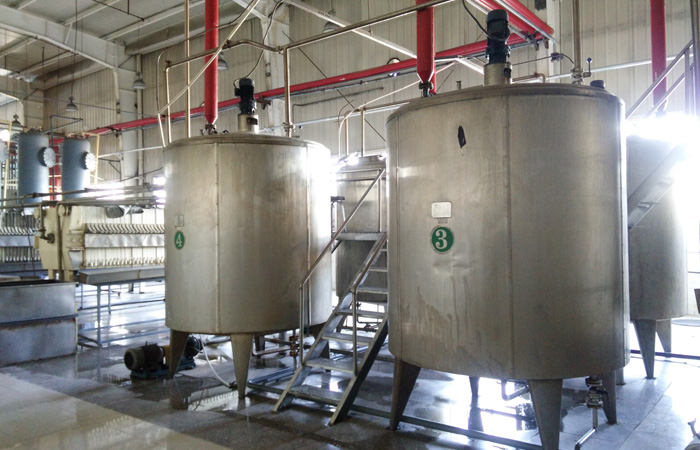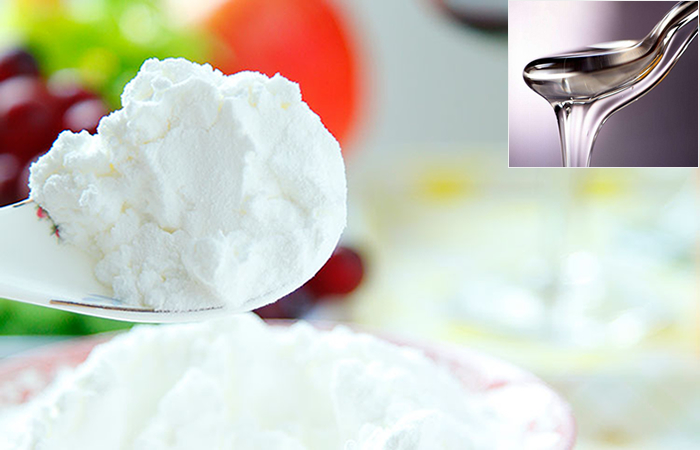Maltose syrup production process technology
2017-05-15 / Industry news
Traditionally, Maltose syrup production as a major component have been produced by treating barley starch with barley b-amylase. b-Amylases (1,4-a-D-glucan maltohydrolases) are exohydrolases which release maltose from 1,4-a-linked glucans but neither bypass nor hydrolyse 1,6-a-linkages. High-maltose syrups (40 - 50 DE, 45-60% (w/w) maltose, 2 - 7% (w/w) glucose) tend not to crystallise, even below 0C and are relatively non-hygroscopic. They are used for the production of hard candy and frozen deserts.

Syrup production line
High conversion syrups (60 - 70 DE, 30 - 37% maltose, 35 - 43% glucose, 10% maltotriose, 15% other oligosaccharides, all by weight) resist crystallisation above 4C and are sweeter. They are used for soft candy and in the baking, brewing and soft drinks industries. It might be expected that b-amylase would be used to Maltose syrup production from corn starch, especially as the combined action of b-amylase and pullulanase give almost quantitative yields of maltose. This is not done on a significant scale nowadays because presently available b-amylases are relatively expensive, not sufficiently temperature stable (although some thermostable b-amylases from species of Clostridium have recently been reported) and are easily inhibited by copper and other heavy metal ions. Instead fungal a-amylases, characterised by their ability to hydrolyse maltotriose (G3) rather than maltose (G2) are employed often in combination with glucoamylase. Presently available enzymes, however, are not totally compatible; fungal a-amylases requiring a pH of not less than 5.0 and a reaction temperature not exceeding 55C.
Maltose syrup production from liquefied starch of around 11 DE at a concentration of 35% dry solids using fungal a-amylase alone. Saccharification occurs over 48 h, by which time the fungal a-amylase has lost its activity. Now that a good pullulanase is available, it is possible to use this in combination with fungal a-amylases to produce syrups with even higher maltose contents.
High-conversion syrups are produced using combinations of fungal a-amylase and glucoamylase. These may be tailored to customers' specifications by adjusting the activities of the two enzymes used but inevitably, as glucoamylase is employed, the glucose content of the final product will be higher than that of high-maltose syrups. The stability of glucoamylase necessitates stopping the reaction, by heating, when the required composition is reached. It is now possible to produce starch hydrolysates with any DE between 1 and 100 and with virtually any composition using combinations of bacterial a-amylases, fungal a-amylases, glucoamylase and pullulanase.

Syrup production line
High conversion syrups (60 - 70 DE, 30 - 37% maltose, 35 - 43% glucose, 10% maltotriose, 15% other oligosaccharides, all by weight) resist crystallisation above 4C and are sweeter. They are used for soft candy and in the baking, brewing and soft drinks industries. It might be expected that b-amylase would be used to Maltose syrup production from corn starch, especially as the combined action of b-amylase and pullulanase give almost quantitative yields of maltose. This is not done on a significant scale nowadays because presently available b-amylases are relatively expensive, not sufficiently temperature stable (although some thermostable b-amylases from species of Clostridium have recently been reported) and are easily inhibited by copper and other heavy metal ions. Instead fungal a-amylases, characterised by their ability to hydrolyse maltotriose (G3) rather than maltose (G2) are employed often in combination with glucoamylase. Presently available enzymes, however, are not totally compatible; fungal a-amylases requiring a pH of not less than 5.0 and a reaction temperature not exceeding 55C.
Maltose syrup production from liquefied starch of around 11 DE at a concentration of 35% dry solids using fungal a-amylase alone. Saccharification occurs over 48 h, by which time the fungal a-amylase has lost its activity. Now that a good pullulanase is available, it is possible to use this in combination with fungal a-amylases to produce syrups with even higher maltose contents.
High-conversion syrups are produced using combinations of fungal a-amylase and glucoamylase. These may be tailored to customers' specifications by adjusting the activities of the two enzymes used but inevitably, as glucoamylase is employed, the glucose content of the final product will be higher than that of high-maltose syrups. The stability of glucoamylase necessitates stopping the reaction, by heating, when the required composition is reached. It is now possible to produce starch hydrolysates with any DE between 1 and 100 and with virtually any composition using combinations of bacterial a-amylases, fungal a-amylases, glucoamylase and pullulanase.





